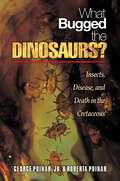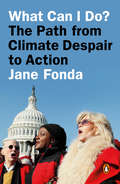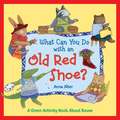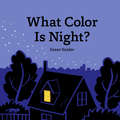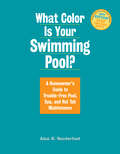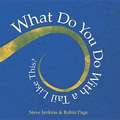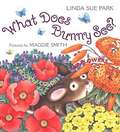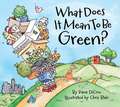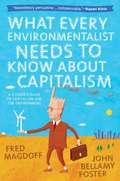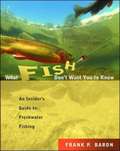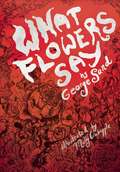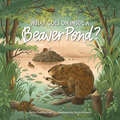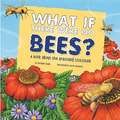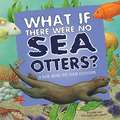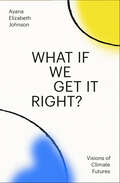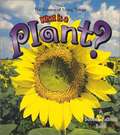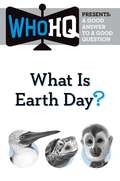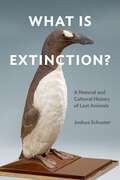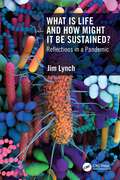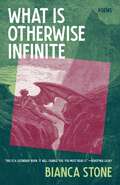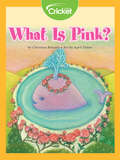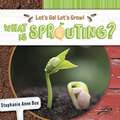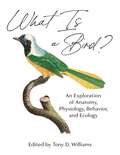- Table View
- List View
What Bugged the Dinosaurs?: Insects, Disease, and Death in the Cretaceous
by Roberta Poinar George PoinarMillions of years ago in the Cretaceous period, the mighty Tyrannosaurus rex--with its dagger-like teeth for tearing its prey to ribbons--was undoubtedly the fiercest carnivore to roam the Earth. Yet as What Bugged the Dinosaurs? reveals, T. rex was not the only killer. George and Roberta Poinar show how insects--from biting sand flies to disease-causing parasites--dominated life on the planet and played a significant role in the life and death of the dinosaurs. The Poinars bring the age of the dinosaurs marvelously to life. Analyzing exotic insects fossilized in Cretaceous amber at three major deposits in Lebanon, Burma, and Canada, they reconstruct the complex ecology of a hostile prehistoric world inhabited by voracious swarms of insects. The Poinars draw upon tantalizing new evidence from their amazing discoveries of disease-producing vertebrate pathogens in Cretaceous blood-sucking flies, as well as intestinal worms and protozoa found in fossilized dinosaur excrement, to provide a unique view of how insects infected with malaria, leishmania, and other pathogens, together with intestinal parasites, could have devastated dinosaur populations. A scientific adventure story from the authors whose research inspired Jurassic Park, What Bugged the Dinosaurs?? offers compelling evidence of how insects directly and indirectly contributed to the dinosaurs' demise.
What Can I Do?: My Path from Climate Despair to Action
by Jane FondaA call to action from Jane Fonda, one of the most inspiring activists of our time, urging us to wake up to the looming disaster of climate change and equipping us with the tools we need to join her in protest <p><p> "This is the last possible moment in history when changing course can mean saving lives and species on an unimaginable scale. It's too late for moderation." <p> In the fall of 2019, frustrated with the obvious inaction of politicians and inspired by Greta Thunberg, Naomi Klein, and student climate strikers, Jane Fonda moved to Washington, D.C., to lead weekly climate change demonstrations on Capitol Hill. On October 11, she launched Fire Drill Fridays, and has since led thousands of people in nonviolent civil disobedience, risking arrest to protest for action. In What Can I Do?, Fonda weaves her deeply personal journey as an activist alongside conversations with and speeches by leading climate scientists and inspiring community organizers, and dives deep into the issues, such as water, migration, and human rights, to emphasize what is at stake. Most significantly, Fonda equips us all with the tools we need to join her in protest, so that everyone can work to combat the climate crisis. <p> No stranger to protest, Fonda's life has been famously shaped by activism. And now she is once again galvanizing the public to take to the streets. Many are already aware of the looming disaster of climate change and realize that a moral responsibility rests on our shoulders. In 2019, we saw atmospheric concentrations of greenhouse gases hit the highest level ever recorded in human history, and our window of opportunity to act is quickly closing. We are facing a climate crisis, but we're also facing an empathy crisis and an inequality crisis; the surge of protests over police violence against black Americans has once again highlighted the links between racism and environmental degradation in our country. It isn't only earth's life-support systems that are unraveling. So too is our social fabric. This is going to take an all-out war on drilling and fracking and deregulation and racism and misogyny and colonialism and despair all at the same time. <p> As Annie Leonard, executive director of Greenpeace USA and Fonda's partner in developing Fire Drill Fridays, has declared, "Change is inevitable; by design, or by disaster." Together, we can commandeer change for the positive—but it will require collective actions taken by social movements on an unprecedented scale. The problems we face now require every one of us to join the fight. The fight for not only our immediate future, but for the future of generations to come.
What Can You Do with an Old Red Shoe?: A Green Activity Book About Reuse
by Anna AlterWhat can Ruby do with her old red show? Use it as a planter for pansies! In this "green" craft book, children can appreciate that recycling is a part of everyday life, and with a little creativity, exciting projects are only a few steps away. Turn a worn flip-flop into an art stamp, a ripped shower curtain into an apron, and an old T-shirt into a pillow. These activities are just a few of the many crafts to be explored. With easy-to-follow instructions, this interactive book will challenge kids to come up with clever recycling ideas of their own in no time!
What Color Is Night?
by Grant SniderLook closer. Grant Snider's beautiful debut picture book explores the wonders—and colors—of nighttime. For night is not just black and white. Ending in colors yet unseen, and a night of sweet dreams, this lilting lullaby is sure to comfort those drifting off to sleep. With luminous art as spare and glowing as the moon, and lyrical text that reads like a friend leading the way through the wilderness, What Color Is Night? is a rich and timeless look at a topic of endless fascination, and a perfect bedtime read-aloud.
What Color Is Your Swimming Pool?: A Homeowner's Guide to Trouble-Free Pool, Spa, and Hot Tub Maintenance
by Alan SanderfootKeep your swimming pool, spa, or hot tub clean and inviting with beautiful sparkling water. Covering all essential maintenance procedures, this easy-to-use guide shows you how to expertly and inexpensively care for your backyard water features. With advice on everything from basic cleaning routines to doing your own repairs, Alan E. Sanderfoot tells you what you need to know about water filtration systems, pumps, motors, heaters, winterizing, and more. Enjoy the pleasures of healthy, crystal-clear water for less money and less trouble! This publication conforms to the EPUB Accessibility specification at WCAG 2.0 Level AA.
What Do You Do With a Tail Like This?
by Steve JenkinsA nose for digging? Ears for seeing? Eyes that squirt blood? Explore the many amazing things animals can do with their ears, eyes, mouths, noses, feet, and tails in this beautifully illustrated interactive guessing book by Steve Jenkins and Robin Page.<P><P> <b>Winner of the Caldecott Honor</b>
What Does Bunny See?
by Linda Sue ParkA rabbit explores a garden, finding flowers of every color, before hopping home for a nap and dreams of rainbows. Rhyming clues invite the reader to answer the question: What does bunny see? Linda Sue Park’s sprightly verses and Maggie Smith’s cheerful illustrations will delight young children, as each turn of the page yields a colorful surprise.
What Does It Mean To Be Green?
by Chris Blair Rana DiOrioDrawing on two sides of your paper instead of just one. Walking to the park instead of getting a ride. Turning off the water while you brush your teeth. A young boy and girl explore all the different ways they can be Green over the course of a day. They discover lots of amazing facts (like our food travels an average of 1,500 miles to be on our plate!) and realize there's so much they-and we-can do to save our world!
What Every Environmentalist Needs to Know About Capitalism
by Fred Magdoff John Bellamy FosterThere is a growing consensus that the planet is heading toward environmental catastrophe: climate change, ocean acidification, ozone depletion, global freshwater use, loss of biodiversity, and chemical pollution all threaten our future unless we act. What is less clear is how humanity should respond. The contemporary environmental movement is the site of many competing plans and prescriptions, and composed of a diverse set of actors, from militant activists to corporate chief executives. This short, readable book is a sharply argued manifesto for those environmentalists who reject schemes of "green capitalism" or piecemeal reform. Environmental and economic scholars Magdoff and Foster contend that the struggle to reverse ecological degradation requires a firm grasp of economic reality. Going further, they argue that efforts to reform capitalism along environmental lines or rely solely on new technology to avert catastrophe misses the point. The main cause of the looming environmental disaster is the driving logic of the system itself, and those in power--no matter how "green"--are incapable of making the changes that are necessary. What Every Environmentalist Needs To Know about Capitalism tackles the two largest issues of our time, the ecological crisis and the faltering capitalist economy, in a way that is thorough, accessible, and sure to provoke debate in the environmental movement.
What Fish Don't Want You To Know: An Insider's Guide to Freshwater Fishing
by Frank P. BaronExpert, field-tested advice for anglers at every level. This comprehensive, entertaining, and foolproof guide covers everything novice and avid anglers need to know to catch freshwater fish--from bass and trout to salmon and walleye--and reveals the two basic ways to catch ALL fish. With numerous photographs and illustrations, easy-to-follow instructions, and a liberal dose of good humor, the author shares his 40 years of angling expertise, including how to read the waters and the weather, select the right baits and lures for particular fish and situations, know which gear is essential and which is merely desirable, get maximum results on a minimum budget, practice proper etiquette and ethics, and to turn a tough day into a great one with dozens of tricks and tips. Laced with amusing anecdotes, this book will unlock the secrets of fishing and teach anglers how to catch more fish.
What Flowers Say
by George Sand Molly Crabapple Holly Erskine HirkoRoses plead to go out to dance; an old oak tree offers advice; paintings of gods and goddesses come alive. In What Flowers Say, renowned writer George Sand dares children to fantasize, to believe in an alternate world. This magical collection, originally penned for her grandchildren, calls into question what is real, a life lesson from someone who refused to accept the gender roles available to women in the nineteenth century. Sand shares her love and immense knowledge of science and mythology, engages issues of class and character, and captures the wonder and determination of a curious child, offering all of us a true sense of infinite possibilities--well beyond the world we live in.George Sand (1804-76) is considered the first professional woman writer of fiction. She wrote many novels, including Indiana and Léila, plays, newspaper articles, and a memoir, Story of My Life. The movie Impromptu is based on her life.Molly Crabapple is a painter, illustrator, and writer based in New York. She has written many books, including Discordia and Week in Hell, and produced work on subjects including the Spanish general strike, her former career as a pinup model, her arrest during Occupy Wall Street, and her visit to Guantanamo Bay. Her illustrated memoir, Drawing Blood, is forthcoming in 2015.
What Goes on inside a Beaver Pond?
by Becky Cushing GopDive into the fascinating world of beavers—the swimmers, builders, and engineers of the animal kingdom! What Goes on inside a Beaver Pond? takes kids ages 8 to 10 on a journey through a year in the life of a young beaver (called a "kit"). This is an exciting year as the young beaver leaves her family lodge and moves throughout the Yokun Brook waterways, seeking a new home for herself. Throughout the seasons, vibrant illustrations and descriptions reveal the hidden inner-workings of a beaver lodge, how beavers fell trees with their teeth and create a wetland habitat, how they collect food and ward off predators, and what daily life is like within a beaver colony. Educational side panels enhance the story with details about beaver behavior and anatomy, as well as information about what other animal inhabitants of the pond are up to throughout the year. Author Becky Cushing Gop is an environmental educator and director of Mass Audubon&’s Pleasant Valley Wildlife Sanctuary where the story takes place. Nature illustrator Carrie Shryock&’s lively and charming graphics bring the young beaver&’s story to life for nature-curious kids.
What Happens to Our Trash? (Let's-Read-and-Find-Out Science 2)
by D. J. WardRead and find out about how we can reduce, reuse, and recycle in this colorfully illustrated nonfiction picture book."Perfect for classes just beginning to study environmental concerns," wrote School Library Journal. "Engaging prose and upbeat, gently humorous illustrations introduce the importance of proper trash disposal and recycling."This is a clear and appealing science book for early elementary age kids, both at home and in the classroom. In clear language and art, including diagrams, the book takes readers through such details as how much trash each person creates every day (on average), where the trash goes, and ways kids can make a difference. It concludes with instructions on how to create a compost pileWhat Happens to Our Trash is a Level 2 Let's-Read-and-Find-Out, which means the book explores more challenging concepts for children in the primary grades. The 100+ titles in this leading nonfiction series are:hands-on and visualacclaimed and trustedgreat for classroomsTop 10 reasons to love LRFOs:Entertain and educate at the same timeHave appealing, child-centered topicsDevelopmentally appropriate for emerging readersFocused; answering questions instead of using survey approachEmploy engaging picture book quality illustrationsUse simple charts and graphics to improve visual literacy skillsFeature hands-on activities to engage young scientistsMeet national science education standardsWritten/illustrated by award-winning authors/illustrators & vetted by an expert in the fieldOver 130 titles in print, meeting a wide range of kids' scientific interestsBooks in this series support the Common Core Learning Standards, Next Generation Science Standards, and the Science, Technology, Engineering, and Math (STEM) standards. Let's-Read-and-Find-Out is the winner of the American Association for the Advancement of Science/Subaru Science Books & Films Prize for Outstanding Science Series.
What If There Were No Bees?: A Book About The Grassland Ecosystem
by Carol Schwartz Suzanne SladeGrassland ecosystems can be found on nearly every continent. Countless animals and plants live in them. So what difference could the loss of one animal species make? Follow the chain reaction, and discover how important honey bees are.
What If There Were No Sea Otters?: A Book About The Ocean Ecosystem
by Carol Schwartz Suzanne SladeThe ocean ecosystem is huge, covering most of our planet. Countless animals and plants live there. So what difference could the loss of one animal species make? Follow the chain reaction, and discover how important sea otters are.
What If We Get It Right?: Visions of Climate Futures
by Ayana Elizabeth Johnson&“With a thoughtfully curated series of essays, poetry, and conversations, the brilliant scientist and climate expert Ayana Elizabeth Johnson has assembled a group of dynamic people who are willing to imagine what seems impossible, and articulate those visions with enthusiastic clarity.&”—Roxane GayOur climate future is not yet written. What if we act as if we love the future?Sometimes the bravest thing we can do while facing an existential crisis is imagine life on the other side. This provocative and joyous book maps an inspiring landscape of possible climate futures.Through clear-eyed essays and vibrant conversations, infused with data, poetry, and art, Ayana Elizabeth Johnson guides us through solutions and possibilities at the nexus of science, policy, culture, and justice. Visionary farmers and financiers, architects and advocates, help us conjure a flourishing future, one worth the effort it will take—from every one of us, with whatever we have to offer—to create.If you haven&’t yet been able to picture a transformed and replenished world—or to see yourself, your loved ones, and your community in it—this book is for you. If you haven&’t yet found your role in shaping this new world or you&’re not sure how we can actually get there, this book is for you.With grace, humor, and humanity, Johnson invites readers to ask and answer this ultimate question together: What if we get it right?On possibility and transformation with:Paola Antonelli • Xiye Bastida • Jade Begay • Wendell Berry • Régine Clément • Steve Connell • Erica Deeman • Abigail Dillen • Brian Donahue • Jean Flemma • Kelly Sims Gallagher • Rhiana Gunn-Wright • Olalekan Jeyifous • Corley Kenna • Bryan C. Lee Jr. • Franklin Leonard • Adam McKay • Bill McKibben • Kate Marvel • Samantha Montano • Kate Orff • Leah Penniman • Marge Piercy • Colette Pichon Battle • Kendra Pierre-Louis • Judith D. Schwartz • Jigar Shah • Ayisha Siddiqa • Bren Smith • Oana Stănescu • Mustafa Suleyman • Jacqueline Woodson
What Is A Plant? (The Science Of Living Things)
by Bobbie KalmanPlants provide people and animals with food, shelter, and even oxygen. Plants help us live and grow, but how does a plant grow? Where do plants grow? What is a Plant? introduces young readers to a variety of plant types, including ferns, carnivorous plants, mosses, and trees. This fact-filled book explains:-photosynthesis-different methods of reproduction-how seeds germinate and grow-which types of plants grow in different climates-how plants defend themselves
What Is Climate Change? (What Was?)
by Gail Herman John Hinderliter Who HqLearn more about what climate change means and how it's affecting our planet.The earth is definitely getting warmer. There's no argument about that, but who or what is the cause? And why has climate change become a political issue? Are humans at fault? Is this just a natural development? While the vast majority of scientists who study the environment agree that humans play a large part in climate change, there is a counterargument. Author Gail Herman presents both sides of the debate in this fact-based, fair-minded, and well-researched book that looks at the subject from many perspectives, including scientific, social, and political.
What Is Earth Day?: A Good Answer to a Good Question
by Who HqDirect from Who HQ, the team that brings you the New York Times Best-Selling Who Was? biography series, comes Who HQ Presents. These short illustrated e-Books provide quick, simple answers to the important questions being asked today about politics, social issues, the environment, and more!What is Earth Day? Wonder no more: Who HQ Presents answers about how this environmental celebration came about, and how you can join in.
What Is Extinction?: A Natural and Cultural History of Last Animals
by Joshua SchusterWINNER, 25th ANNUAL SUSANNE M. GLASSCOCK BOOK PRIZELife on Earth is facing a mass extinction event of our own making. Human activity is changing the biology and the meaning of extinction. What Is Extinction? examines several key moments that have come to define the terms of extinction over the past two centuries, exploring instances of animal and human finitude and the cultural forms used to document and interpret these events.Offering a critical theory for the critically endangered, Joshua Schuster proposes that different discourses of limits and lastness appear in specific extinction events over time as a response to changing attitudes toward species frailty. Understanding these extinction events also involves examining what happens when the conceptual and cultural forms used to account for species finitude are pressed to their limits as well. Schuster provides close readings of several case studies of extinction that bring together environmental humanities and multispecies methods with media-specific analyses at the terminus of life.What Is Extinction? delves into the development of last animal photography, the anthropological and psychoanalytic fascination with human origins and ends, the invention of new literary genres of last fictions, the rise of new extreme biopolitics in the Third Reich that attempted to change the meaning of extinction, and the current pursuit of de-extinction technologies. Schuster offers timely interpretations of how definitions and visions of extinction have changed in the past and continue to change in the present.
What Is Life and How Might It Be Sustained?: Reflections in a Pandemic
by Jim LynchHow did the universe and life begin and what are the threats to people and the environment in a pandemic? This book is for anybody with interest in protecting life on the planet. Studies on the origin of life and scientific contributions to safeguarding the planet are examined in light of current thinking on climate change. A major focus is the spread of microbes, put in the context of environmental assessment and management, including descriptions of microbiomes and a consideration of the risks of genetic modifications. Professor Lynch shows how failure to control disease can lead to the collapse of any biotic population. To avoid this, the ethics of management of disease by biological control and by vaccination are discussed, at the practical level and in a moral theological context.
What Is Otherwise Infinite: Poems
by Bianca StoneFinalist for the New England Book Award in Poetry and the Vermont Book Award As heard on NPR Morning Edition A New York Public Library Best Book of 2022 A searching, startling new collection of poems from the author of The Möbius Strip Club of Grief and Someone Else’s Wedding Vows Written in four sections with incisive and vivid lyrical language, Bianca Stone’s What Is Otherwise Infinite considers how we find our place in the world through themes of philosophy, religion, environment, myth, and psychology. “I deal only in the hardest pain-revivers, symbols and tongues,” writes Stone. “I want to tell you only / in the intimacy of our discomfort.” Populated by Archangels, limping in paradise; by allergies of the soul; the intimacy and danger of motherhood; psychic wounds; and dirty, dirty chocolate layer cake, What Is Otherwise Infinite deftly examines our inherent and inherited ideas of how to live, and the experience of the Self—which on one hand is so intensely personal, and on the other, universal.
What Is Pink?
by Christina RossettiEverywhere you look, there are beautiful colors throughout nature!
What Is Sprouting? (Let’s Go! Let’s Grow!)
by Stephanie Anne BoxIntroduce your child to science, biology, and plant life with the children’s book What Is Sprouting?Did you know that plants are also living things? Learn about the life cycle of a plant from its beginnings as a seed to how they are helpful to humans.Storybook Features:This children’s book features new vocabulary, a photo glossary, an index, and reading activity.24 pages of vivid photographsLexile 290LAbout RourkeWe proudly publish respectful and relevant non-fiction and fiction titles that represent our diverse readers, and are designed to support reading on a level that has no limits!
What Is a Bird?: An Exploration of Anatomy, Physiology, Behavior, and Ecology
by Tony D. Williams Scott McWilliams Julia A. Clarke Elizabeth MacDougall-Shackleton Scott MacDougall-Shackleton Frances Bonier Chad EliasonA large-format, beautifully illustrated look at the natural history of birdsThere are some 10,000 bird species in existence today, occupying every continent and virtually every habitat on Earth. The variety of bird species is truly astounding, from the tiny bee hummingbird to the large flightless ostrich, making birds one of the most diverse and successful animal groups on the planet. Taking you inside the extraordinary world of birds, What Is a Bird? explores all aspects of these remarkable creatures, providing an up-close look at their morphology, unique internal anatomy and physiology, fascinating and varied behavior, and ecology. It features hundreds of color illustrations and draws on a broad range of examples, from the familiar backyard sparrow to the most exotic birds of paradise. A must-have book for birders and armchair naturalists, What Is a Bird? is a celebration of the rich complexity of bird life.An absorbing and beautifully presented exploration of the natural history of birdsIntegrates physiological adaptations with ecology and behaviorFeatures a wealth of color photographs and explanatory figuresUses scanning electron microscope imagery to provide a rare close-up view of structures not normally visibleProvides insights into our complex relationship with birds, from our enduring fascination with them to the threats they face and the challenges of conservation
